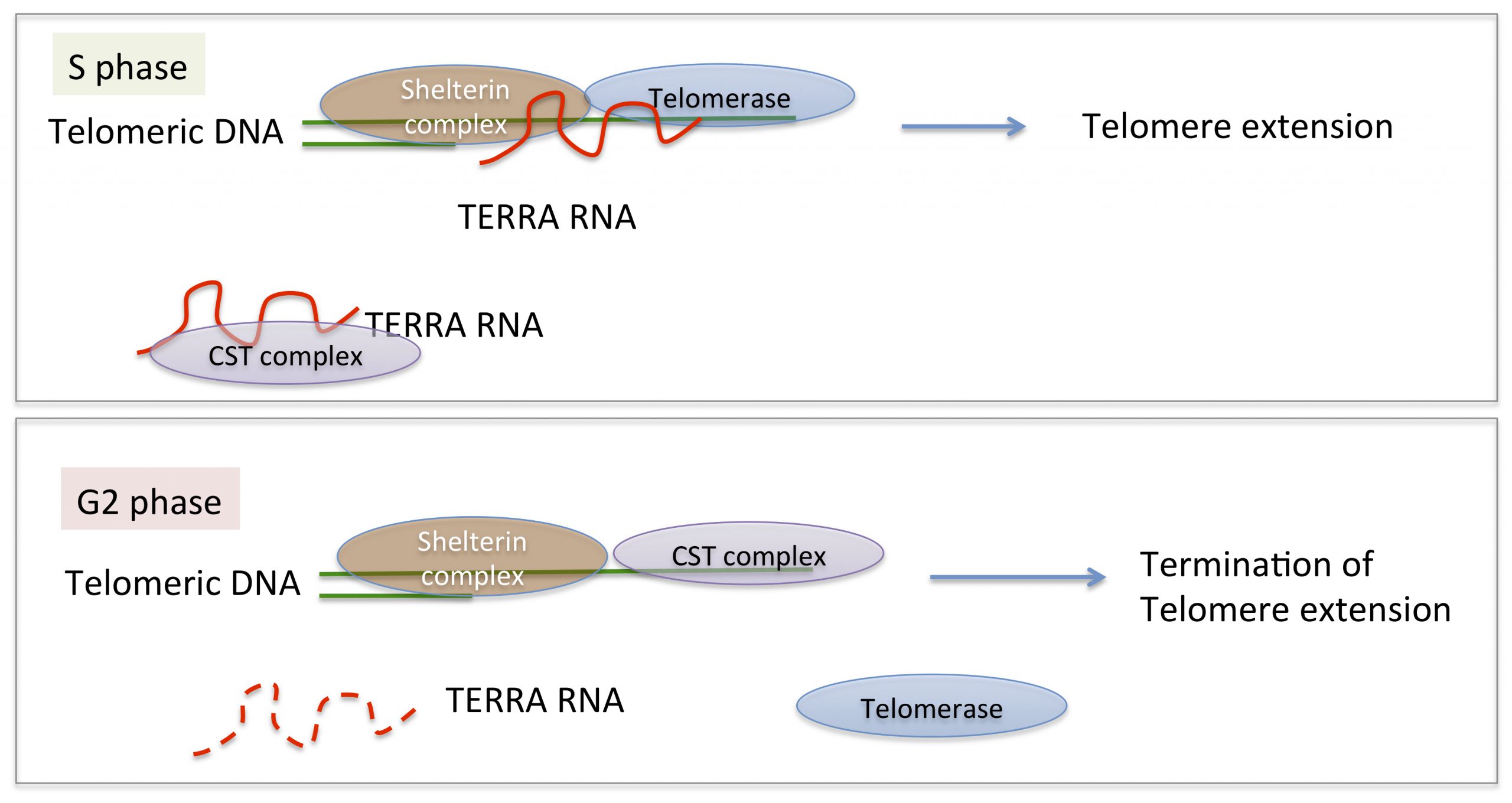端粒RNA 與CST 蛋白體的交互作用來調控端粒的完整性
TERRA-CST interaction in regulating telomere integrity
The discovery of massive transcription of large RNA transcripts that do not code for proteins, termed long noncoding RNAs (lncRNAs), provides a new perspective on the centrality of RNA in diverse functions. Unlike DNA, RNA is more mobile and is able to relocate to other genomic loci or transport outside the nucleus. Recent studies have shown that lncRNAs can act as a molecular scaffold, decoy, and guide for proteins. Since single-stranded RNA is somewhat similar to single-stranded DNA in the aspect of nucleotide base property. Here we study telomeric repeat-containing RNA, TERRA, transcribed from subtelomeric regions towards to telomeric ends in the regulation of telomere maintenance.
Telomere dysfunction leads to chromosomal abnormalities, premature aging, and even cancer.
Telomere lengthening is mediated by telomerase RNA-protein complex, which extends telomeric DNA at 3’ ends of chromosomes using its telomerase reverse transcriptase (TERT) and an RNA template (TERC). There are protein complexes that protect telomere ends and essential for telomere maintenance: shelterin and CST. Shelterin is a six subunit complex consisting of TRF1, TRF2, TIN2, RAP1, POT1, TPP1, and localizes specifically to double- and single-stranded telomeric DNA. Shelterin caps the ends of chromosomes by promoting T-loop formation and by sequestering the single-stranded DNA portion of the telomere. POT1-TPP1 complex could serve as a telomerase processivity factor by recruiting telomerase to telomeres during telomere extension. The CST is a trimeric complex composed of Ctc1, Stn1, and Ten1 in higher eukaryotes. CST associates specifically with the single-stranded telomeric DNA and localizes to telomeres where it is involved in telomere duplex replication and telomere length regulation.
Telomere replication is a dynamic process, which involves shuffling telomeric DNA binding proteins including shelterin complex, telomerase, and CST complex to telomeric DNA. It is known that TERRA is part of telomere architecture, but how TERRA interplays with telomere binding proteins to regulate telomere maintenance is poorly understood. We have recently found that TERRA binds to telomerase complex, shelterin proteins, and CST complex. Here we reveal that TERRA binds to CTC1 and regulates the recruitment of telomerase to telomeres. TERRA depletion reduces the recruitment of TERT to telomeres, while increases POT1 and CTC1 loading at telomeres. We observed that TERRA is upregulated in the mid-S phase in which TERT is enriched at telomeres for extending G-strand telomeric DNA. Our results support the role of TERRA in telomere extensión and replication. We propose that TERRA complete with telomeric DNA for telomeric DNA binding proteins in a cell cycle-dependent manner to modulate the telomere maintenance.
端粒為染色體末端的保護性結構,與老化調控、癌症等息息相關。端粒的不穩定會導致基因體的穩定性下降,引起許多人類的疾病。端粒的維持是依賴許多因子來調控,包含端粒酶(telomerase)和包覆在端粒上的蛋白質。人類的端粒DNA是由重複序列TTAGGG所組成,其構造包含雙股區與最尾端的單股區(稱之為G-strand overhang),在細胞複製時為了不讓端粒變短,需要端粒酶利用RNA當模板反轉錄加上TTAGGG序列在G-tail上的單股區,之後,在另一股(C-strand)補上DNA來完成端粒的複製,稱之為C-strand fill in。其中CST複合體可以調控端粒酶活性,幫助端粒DNA的複製與C-strand fill in。
端粒的複製是一種動態的過程,其中不同的蛋白質會在端粒上移動。我們之前的研究發現端粒非編碼RNA──TERRA會與這些包覆在端粒DNA上的蛋白質結合,但是TERRA如何調控端粒的複製與延長還不清楚。我們最新的研究發現TERRA的表現在細胞週期S phase中表現最高,並在G2 phase時下降,TERRA可直接與CTC1結合,TERRA的缺失會影響端粒酶與包覆端粒的蛋白質移動到端粒DNA上。我們推測當細胞週期進入S phase時,TERRA與CTC1結合,阻止CST複合體到端粒DNA上,當細胞週期進入G2 phase,TERRA量下降使CTC1更易與端粒DNA結合,這樣可以在細胞增生時準確的來調控何時需要加長端粒與何時需要複製端粒DNA。

